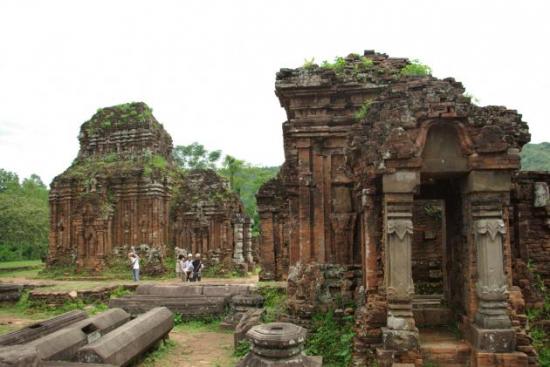Nguyen Thi Thuy Anh, Zhang Jianhua
Source - http://www.nationmultimedia.com/sunday/Secrets-of-My-Son-Sanctuary-30216940.html

The religious heart of Vietnam's ancient Champa Kingdom holds many mysteries for modern visitors
Visitors to the My Son Sanctuary, located 650 kilometres south of Hanoi, still marvel at the remarkable architectural ensemble built over a thousand years from the fourth to the 13th century.
The Hindu sanctuary, which was declared world heritage site by the United Nations, presents a vivid picture of spiritual and political life in an important phase of Vietnam's history.
Its signature features include a series of spectacular ornate temple towers that spring up from a valley surrounded by mountains. The area was the religious centre for the capital of the Champa Kingdom.
"There is a lot about the Cham temples that remains a mystery, including to the Vietnamese themselves," tour guide Vo Van Nhut tells us.
Visitors have puzzled for decades over how the Cham built the temples and how they made the bricks.
"The bricks here are more than a thousand years old, but they remain sturdy. Nobody knows about the technology used by the Cham people, and even archaeologists cannot explain how this was possible."
Nhut adds that one of the biggest mysteries in My Son concerns the amazing longevity of the temples, which remain in good condition when equivalent complexes in Southeast Asia have long since crumbled. Vietnamese archaeologists theorise that an organic resin was used to cement the bricks together, but "no one knows for sure what kind of materials the builders utilised".
The kiln-fired bricks of the temples in My Son carry stone pillars decorated with sandstone bas-reliefs depicting scenes from Hindu mythology. The technological sophistication is testament to Cham engineering skills, while the elaborate iconography and symbolism of the towers give insight into the content and evolution of Cham religious and political thought.
"It's easy to tell the difference between the original walls and those restored in succeeding centuries. As a finishing touch for the temples, Cham artisans smeared a special mortar to form a hard, protective carapace," explains Nhut.
The old walls have a bright colour, while the restored walls are darker, he adds.
Abandoned for centuries, My Son was rediscovered by French explorers in 1898, and restoration work began in 1937.
In 1979, Vietnam gave My Son Sanctuary protected status as a site of national importance, while Unesco named it World Cultural Heritage in 1999 as a typical example of cultural exchange and a unique artefact of an extinct Asian civilisation.
The 71 temples in My Son were built into groups that follow the same model: a main tower, or kalan, surrounded by smaller towers and secondary monuments. The kalan symbolises Hinduism's sacred Mount Meru, the centre of the universe and abode of the gods. All this will be familiar to anyone who has visited Angkor Wat across the border in Cambodia. The temples of Angkor are built on exactly the same Hindu principles as their Champa counterparts, and both depict the wars fought between the two kingdoms over the centuries.
Another mystery at My Son concerns its decorative carvings. Were the walls first constructed and then carved, or were the bricks carved first and then stacked to create the walls?
Close examination of the carvings reveals no telltale broken lines that would show the bricks had been carved first and then assembled. Archaeologists surmise that craftsmen carved directly onto the finished brick walls, making this a technique unique in Asia.
Like the construction methods, the ancient script at My Son has proved difficult to decipher.
"It's hard to translate the inscriptions here," says Nhut. "The words are derived from Sanskrit and were used by the elite and religious sections of society, not the ordinary people. They date back 800 years and were inscribed with advanced methods so can still be seen very clearly today."